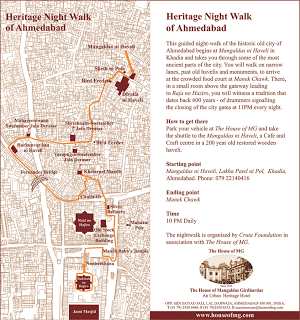A lanky boy in his late teens, wearing jeans and a stripped shirt drummed away into the darkness of the night, as a few of us stood around watching. He sat facing the tomb of Sultan Ahmed Shah, the founder of Ahmedabad. The setting was most ordinary, with a single tube light lending some illumination to the bare room, that had a charpoy (mat) and a couple of metal chairs lying around. He was an ordinary lad in an ordinary setting who helped keep alive the most extraordinary tradition, one that had lasted 600 years. He belonged to a family who to this day pay tribute to Sultan Ahmed Shah, the founder of Ahmedabad.
Legend goes that one day while standing on the banks of the river Sabarmati, Ahmed Shah noticed a small hare chase a ferocious dog. Baffled by this scene, the Sultan went to a learned man, seeking an explanation and it was here that he learned that it was the uniqueness of this land, that cultivated such qualities in those who occupy it. Impressed with what he saw and heard, Ahmed Shah set up Ahmedabad at the very site in 1411.
In 1487, Ahmed Shah’s grandson, Mahmud Begada constructed a wall, ten kilometers in circumference around the city. Twelve gates allowed residents and traders to enter and leave the city. The beats of the drum and strains of the shenai known as naubat, signaled the opening and closing of these gates, amongst other things. To this day descendants of one of the families who played these instruments during the time of the Sultan, continue to play a fifteen minute piece in honor of Ahmed Shah.
Within these gates, the city was divided into three areas, one purely for residential purposes, one for commercial purposes and one that was a mix of both residential and commercial. The residential area was divided into 600 different Pols (pronounced pole). A Pol comprised of a cluster of families who shared a common caste, profession or religion. The first Pol that was setup was called the Mahurat Pol. Mahurat refers to a time or moment that is auspicious, and often marks the beginning of new ventures. The houses inside the Pol, were typically high rise structures comprising at least 2 floors or more. They were built close to each other and residents to this day have to traverse narrow lanes to move around inside. Originally built of teak wood, today almost all the houses are brick constructions, with a few having retained their original intricately carved wooden facades.
The labyrinth of lanes and narrow alleyways ensured that the residents were safe from intruders in earlier times. Secret passages connected one Pol to another. Known only to the residents, these passages were concealed by doors, thus fooling someone into believing that they were just an entrance to another house.
Pol design and architecture warrants a whole different writeup and I hope to go back someday during daytime to see them in all their glory or at least of what is left of it.
_________________________________________________________________________________
I went to these Pols as part of the night walk conducted by the House of MG. They conduct these heritage walks every night. We had to assemble at the House of MG by 10 p.m. and the hour long walk costs INR 200.


2 Comments
Siddhartha Joshi
April 27, 2014 at 4:05 pmNice one Chaitali…always good to learn more about Ahmedabad's history
Chaitali Patel
April 27, 2014 at 5:24 pmThanks for dropping by! I now want to do the morning heritage walk when I am in Ahmedabad next.